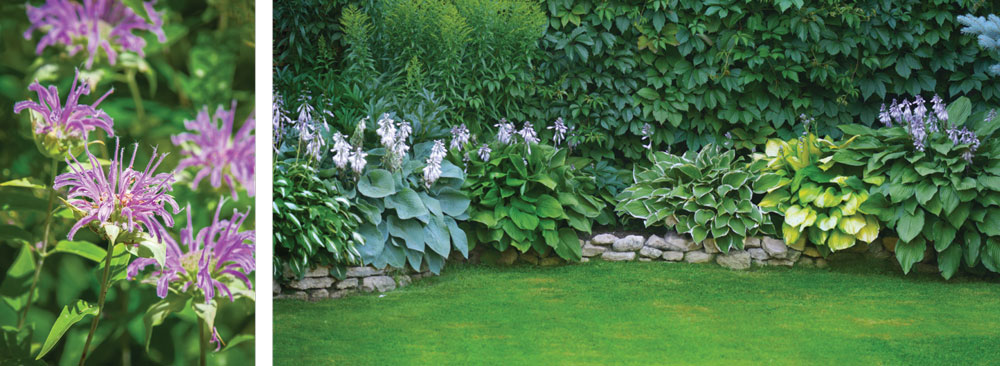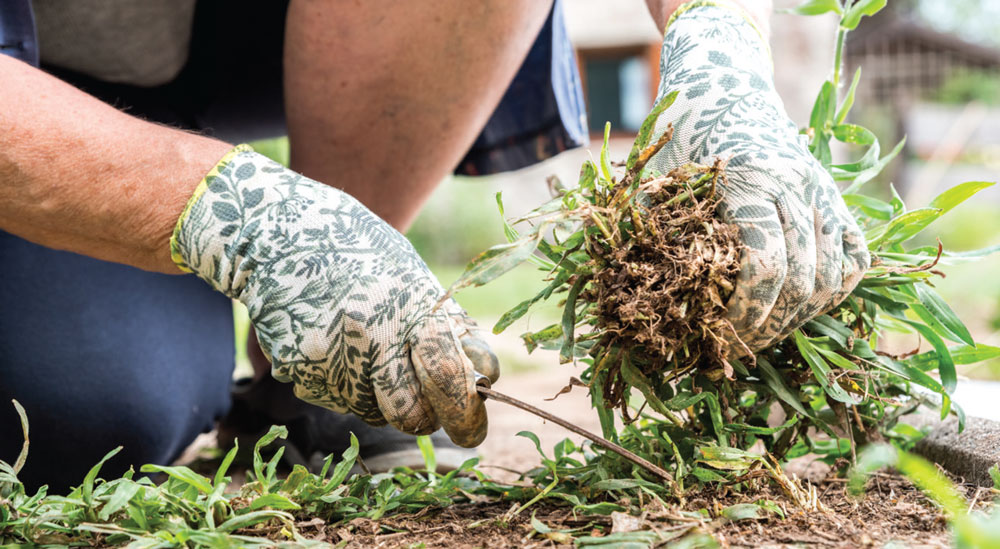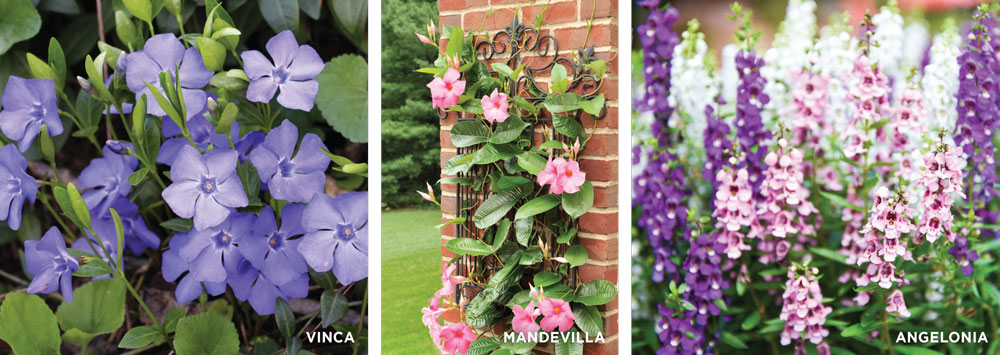SUMMER SURVIVORS
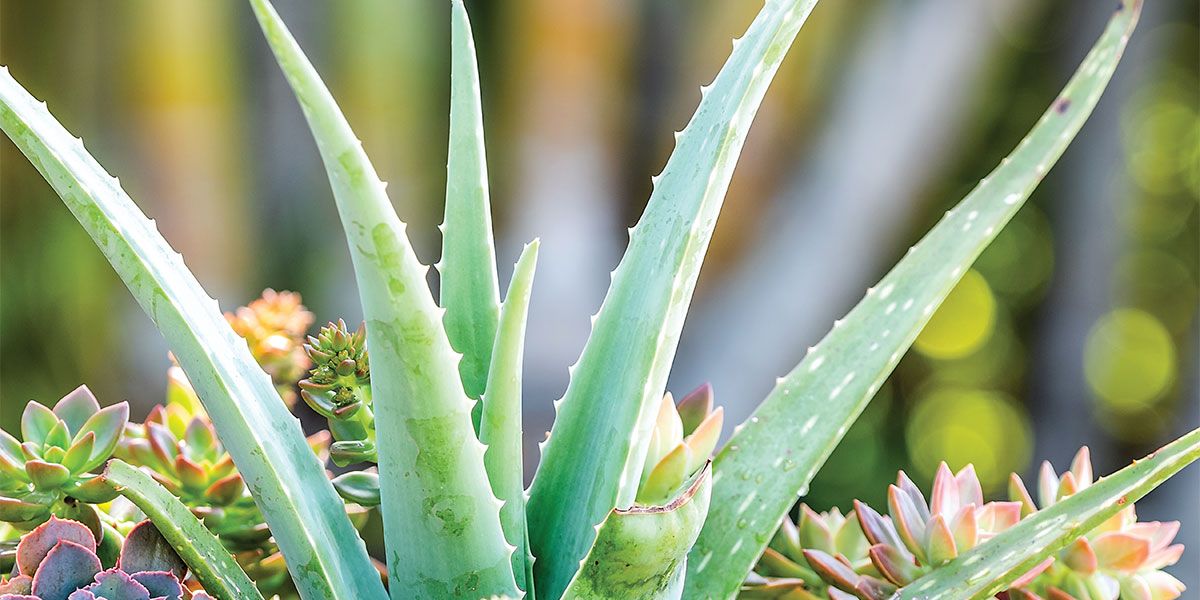
Drought-resistant plants
Why do some plants thrive during prolonged hot weather while others wilt, turn brown, and barely bloom? The answer to this question lies in choosing the right drought-resistant annuals and perennials for the area. By selecting the perfect plants and following a few simple guidelines, you will have healthy flowers regardless of how much rainfall we experience.
Developing survivors
According to Evelyn Elwell of Walter’s Greenhouse in Hardy, “Drought-tolerant means they will require less water than other plants, but they still require water and fertilizer. They eat less at the dinner table, but they still need to eat and drink!” To maximize the chance of summer survival, follow these important strategies:
- Consider where you’ll plant. Select plants that are suitable for your specific growing conditions. For instance, how well does the soil retain moisture? How well does it drain? How much sunlight will it receive? You can improve soil performance by enriching it with compost, manure or mulch.
- Water in early morning or in the evening to minimize loss of water through evaporation. Keep new plants well-watered for their first season or two to allow them to develop that extensive root system. Water all plants well when they first go into the ground.
- Provide shade. The combination of too much direct sun and heat will stress even drought-resistant plants. Mulch is a great option for help with water retention since it absorbs moisture; however, mulch also creates heat as it decomposes. So, mulching at least 5 to 6 inches away from the plants provides protection, but allows the plants to grow. Shade-loving plants can be placed near physical structures that will provide some relief during the hottest parts of the day.
- Group plants together with similar needs for sunlight, nutrients and moisture. Space out new plantings so that they are not overcrowded. Plant smaller annuals and perennials that will adapt to the soil conditions faster and require less water.
- Keep weeds to a minimum to prevent competition with plants for the same moisture.
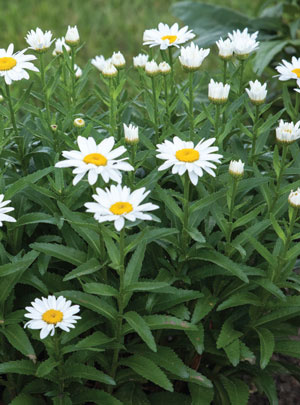 Plants
Plants
From plants to shrubs to succulents, summer survivors are plentiful. Take some time to wander through a local nursery and look for the colors and textures that will draw attention to your yard. Elwell has many suggestions for the perfect plants for the warmer months. “All the varieties I like to suggest require very little care,” she says. “No pinching, plucking or pruning is required. If they get larger than you want, you can always pinch them.”
Her favorites include vinca, also known as periwinkle, a popular choice for its abundant blooms and sweet colors. “Mandevilla, evolvulus, and fibrous begonia are easy, drought-resistant annuals for summer planting,” notes Elwell. Mandevilla, flowering vines, make stunning additions to a trellis or a garden wall. Evolvulus, in the morning glory family, makes a cascade of sweet flowers. Fibrous begonias are packed with white, pink, red or rose blossoms.
Also, another good choice is the angelonia, a summer snapdragon, that produces beautiful spikes of mauve, purple, pink, blue or white flowers all season long. This lovely plant enjoys full sun, but can also tolerate partial shade as long as it gets at least 6 hours of sunshine.
Also, the agastache is a bushy perennial that produces orange, pink or blue flowers from summer to fall. This plant is deer resistant and can be planted in full sunlight. In outdoor pots or containers, the plant may require more frequent watering. Salvia, once established, is drought-resistant and requires little care. It prefers full sun, showing off red, lavender, white, purple, orange or pink flowers.
Lantana, a flowering plant, is known for its clusters of small, bright flowers that come in a variety of color combinations and scream “party” on each bloom. Butterflies and hummingbirds find their way to lantanas!
As for a watering schedule, Elwell suggests, “Water daily for the first week and then every other day for the next two weeks. Then, water as needed. Feed with water-soluble fertilizer for blooming plants every 10 days.”
Enjoy combining annuals and perennials to create a summer display that will offer pops of color throughout the season.
Shrubs
As for shrubs, forsythia and spiraea make beautiful additions to a summer yard. Though they bloom in the spring, the bushes stay fresh all summer. Boxwood is very popular any time of year. Junipers are also nice drought-tolerant shrubs that make a beautiful show in warm weather.
Your choices are many for shrubs to give your yard a fresh and colorful look.
Succulents
A discussion of drought-resistant plants wouldn’t be complete without suggestions for succulents. Elwell recommends portulaca, a low-growing succulent flowering plant. “The varieties propagated from cuttings are vast,” says Elwell. Hens and chicks, sedums, delosperma and yucca are also fun to have in pots or planted in the yard. “Succulents are always a choice for drought-tolerance, but they are typically not flowering,” says Elwell. “Contrast of texture and color of the plant can be beautiful without the blooms.”
Low maintenance and low cost, succulents display a variety of shapes, colors and textures. Perfect for the beginning plant enthusiast, succulents are easy to care for and forgiving. They will succumb to overwatering, though, so be sure to check the soil. “It’s a misnomer that succulents like to be bone dry,” says Elwell. “They prefer to remain evenly moist, but not soggy.”
Throughout the summer, be on the lookout for plants that may need your attention. Perhaps the sun has taken its toll.
When heat stresses your outdoor plants
- Leaves tend to look dull and, as stress from lack of water increases, the leaves may curl or wilt.
- The plant may droop or drop open. At this point, the plant may not rebound even after receiving supplemental water or rain.
- Plant growth slows and may stop altogether.
- Flower buds may not develop or the buds may not open. If they do develop, the flowers may be smaller than normal.
If they do develop, the flowers may be smaller than normal.
If your plants do suffer from a heat stroke, add water and a balanced fertilizer to encourage restored health. A little tender-loving care may rejuvenate the hardier plants.
With the region’s humid summer and dry spells, drought-resistant plants that can survive through periods of low water are a necessity. By selecting the best plants and implementing the best practices, you can enjoy a beautiful yard and garden all summer long. ✦
annuals, drought-resistant plants, drought-tolerant, hot weather, outdoor plants, Perennials, shrubs, succulents
